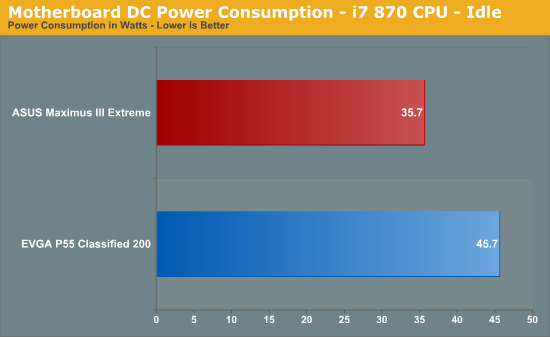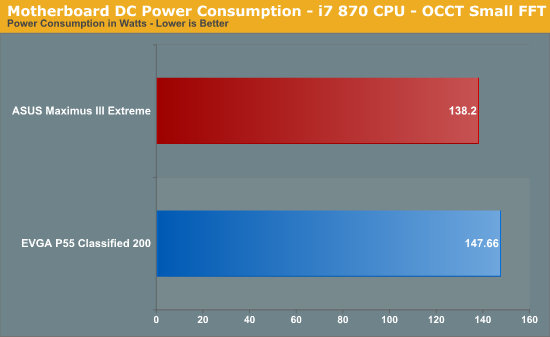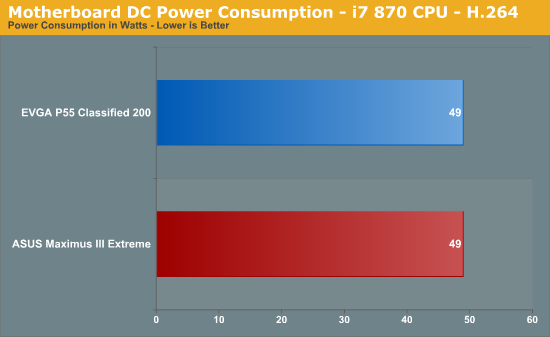ASUS Maximus III Extreme - P55 for $349
by Rajinder Gill on April 26, 2010 1:32 AM EST- Posted in
- Motherboards
Testbed Setup
|
Testbed Setup Overclocking / Benchmark Testbed |
|
| Processor |
1 x Intel i5-870 ES CPU, 2.93GHz, 8 Threads, 8MB Cache Intel i5-750 Retail, 2.66GHz, 4 Threads, 8MB Cache Intel I7 920 D0, 2.66GHz, 8 Threads, 8MB Cache |
| CPU Voltage | Various |
| Cooling | Intel air cooler, Heatkiller 3.0 waterblock, PA120.2 radiator and DDC ultra pump (with Petra top). 1/2 ID tubing for watercooling. |
| Power Supply | Corsair HX950 |
| Memory |
Corsair Dominator GT 8-8-8-24 2200MHz 4GB kit (X2 for 8GB) G.Skill Perfect Storm 8-8-8-24 2200MHz 4GB kit |
| Memory Settings | Various |
| Video Cards | MSI 275 Lightning (stock clocks) |
| Video Drivers | nVidia 195.62 WHQL |
| Hard Drive |
Western Digital 7200RPM 1TB SATA 3/Gbps 32MB OCZ Vertex 120GB SSD |
| Optical Drives | Plextor PX-B900A, Toshiba SD-H802A |
| Case |
Open Test Bed - Dimastech Benching Station Lian-Li V2110 |
| Operating System | Windows 7 64-bit |
| . | |
We utilized memory kits from Corsair and G.Skill to verify memory compatibility on our test boards. Our OS and primary applications are loaded on the OCZ Vertex 120GB SSD drive and our games operate off the WD Caviar Black 1TB drive. We did a clean install of the OS and applications for each motherboard.
We used Intel's stock cooler for the stock comparison testing, while water-cooling via the superlative Heat Killer 3.0 water block was utilized for overclocking. For graphics duty, we used MSI's 275 Lighting GPUs to provide performance comparisons between boards and to test SLI scaling in our gaming benchmarks.
For our test results we set up each board as closely as possible in regards to memory timings. Otherwise all other settings are left on auto. The P55 utilized 8GB of DDR3, while the X58 platform contained 6GB. The P55 and X58 DDR3 timings were set to 7-7-7-20 1T at DDR3-1600 for the i7-920 and i7-870 processors at both stock and overclocked CPU settings.
We used DDR3-1333 6-6-6-18 1T timings for the i5-750 stock setup for all system benchmarks (non gaming tests) as DDR3-1600 is not natively supported at a stock BCLK setting of 133.
Power Consumption
Our power consumption testing utilizes the same batch of components under similar circumstances in a bid to monitor variances between idle and CPU load conditions. We install the vendor supplied power saving utilities on each board and enable power saving modes that don't involve any kind of underclocking or CPU core frequency modulation in order to run an apples to apples comparison.
ATX PSU switching losses are absent from our figures because we monitor power consumption directly at the DC rails of the PSU. These figures measure only the CPU, motherboard and memory DC power draw and exclude any other peripherals such as 12V ATX power draw for the graphics card, or any power for case cooling fans and hard drives etc. Actual AC power consumption for the motherboard will be anywhere from 15~40% higher than these figures depending upon the efficiency of your power supply.



The M3E holds a 10 watt advantage at idle, but seems to draw more power than the EVGA Classified 200 when under full load.










22 Comments
View All Comments
gasgas - Monday, April 26, 2010 - link
Outstanding review anand, some very nice features on the ASUS board, one has to ask though, if P55 is costing this much is it really worth the effort, why not just get a budget X58 and have more on tap.Makaveli - Monday, April 26, 2010 - link
Why are the screenshots so big?I felt I should have been wearing glasses or something... and I don't wear glasses!
classy - Monday, April 26, 2010 - link
$350 is too much for P55. You can get a serious X58 board for that kind of moneyloghead - Monday, April 26, 2010 - link
good luck to everyonedingetje - Tuesday, April 27, 2010 - link
wouldn't pay more than 100 bucks for it though :)v12v12 - Tuesday, April 27, 2010 - link
I dunno maybe it's me, but we're talking near $400 for a system board? Three-hundred and fifty dollars (& ~$26 tax), that's just lunacy to even bother with. Has anyone ever done some basic, logical mathematics on cost/performance? These so-called "performance/'OC'er" mobos offer barely any noticeable advantages over a solid mid-level board vs the exuberant price people will rationalize. Paying nearly 100% more for hardly 15% performance advantage? For the same money you could buy enhanced cooling equipment for your mid-level board and soar past that waste of a PCB, dollar for dollar.The fanaticism over these "top-end," yet financially inefficient mobos, is just laughable; even the suggestion of purchasing one is also. People are rationalizing spending MORE, for lesser performance per dollar; THIS is ILLOGICAL, and stupid? I say Anand spend more time on solid mid to lower-upper builds vs playing fantasy article on a "gold-sample" OC'er board that offers little in reality for; I dunno maybe ~90% of the readership, whom will not be purchasing boards anywhere near that price range? Articles like these waste the writers' time and the readers'. Also it's money down the drain from a budget, which could be spent on better informing majority of the readers on systems they can actually afford or save for. $349, come on lol. That's a very nice trip somewhere on a plane, buddy... Vs an "OC'ers system-board." These prices are ridiculous and you all keep feeding the (advertising) market for them.
__Yep it's ALL marketing folks... they (Manu's/tech sites etc.) know most of you will never get one of these boards, it's just a dream; they are loss-leaders. They know it's great advertising for the manufacturer, who doesn't expect to make a profit from said board. It's to demonstrate to the "market" (their competitors) their current/alleged technological capabilities. All the while we're getting articles, which use up resources from more in depth guides, builds, discussions about what most people have, can afford, or will save for... Fantasy-land articles are great for the uber enthusiast, but it's boring knowing I'm never going to waste anywhere near that much for this stuff... I'll just see it a couple gens later; wow I feel like a psychic, I just knew exactly what board I'll get when the price is right... Bunk.
More meat, less fat please... Thx staff.
Rajinder Gill - Tuesday, April 27, 2010 - link
Hi,This is the first $200+ motherboard review we've posted in 2010. The last 13 boards reviewed were sub $200 (a lot under $150). So I don't think its a case of us getting carried away and not providing any "meat" for the readership.
There will be some high-end boards reviewed over the coming months, but also a number of budget priced ones as time progresses.
regards
Raja
Nickel020 - Tuesday, April 27, 2010 - link
The gaming performance differences between the M3E and the Trinergy are way larger than I've come to expect of same chipset boards: Sometimes the M3E is ~10% faster than the Trinergy, sometimes it's the other way around. If I didn't know that you know what you're doing I'd think this was sloppy benchmarking... How do you explain the large differences? At second glance it looks like the Trinergy does better in multi-GPU setups, while the M3E leads in single GPU setups.Also, I did not expect such a large difference between the 920 @4GHz and the P55 boards with the CPU @4GHz when using triple SLI, is this to be attributed to the NF200, to the on-die PCI-E controller (not enough lanes?) or even the lack of a third memory channel? Is the difference also this big on dual SLI between X58 and P55+NF200 boards? And how do non-NF200 boards fare?
Rajinder Gill - Tuesday, April 27, 2010 - link
Hi,The disparity you see in the M3E and Trinergy multi-card results is not down to 'sloppy benchmarking'. We saw this back when we reviewed the Trinergy board too against the P55 Classified 200. My personal take on the difference is that it’s possibly down to how the NF200 is strung onto the primary PEG lanes.
MSI supplies all 16 lanes direct to the NF200 - this gives them slightly worse single card performance. However, as nVidia have a couple of front end features within the NF200 that can be utilized for SLI, when more than one card is plugged in boards like the M3E and Classified 200 which keep eight of the primary PEG lanes native to the CPU incur a performance hit, possibly due to an additional command hop front to back on the NF200. That's about the only thing I can think that causes this. ASUS have actually added a lot of lane switches to the M3E to provide 4 card support, those little lane switches and trace routing all add extra latency too.
We don't go to press with figures that are out of whack, anything we find with a disparity is double and triple checked before we post it up.
Regards
Raja
Rajinder Gill - Tuesday, April 27, 2010 - link
Forgot to add, for additional results showing other P55 boards with the trinergy - check some of the results here:
http://www.anandtech.com/show/2894/6